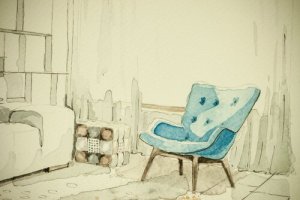Gaston Bachelard: The Poetics of Space

One of Gaston Bachelard’s most memorable books is The Poetics of Space, in which he analyzes the spaces of a house in a particularly striking way.
Very few remarkable intellectuals have delved into the spaces of a house. Bachelard turned the subject into a wonderful poetic reflection and defined it as “topoanalysis”.
“A creature that hides and “withdraws into its shell,” is preparing a “way out.” This is true of the entire scale of metaphors, from the resurrection of a man in his grave, to the sudden outburst of one who has long been silent. If we remain at the heart of the image under consideration, we have the impression that, by staying in the motionlessness of its shell, the creature is preparing temporal explosions, not to say whirlwinds, of being.”
-Gaston Bachelard-
When referring to the spaces of a house, Bachelard indicated that “the house image would appear to have become the topography of our intimate being.” Furthermore, an external space is a reflection of an internal world.
Beloved spaces of a house
Gaston Bachelard points out that houses offer protection. The spaces of a house are lived spaces. Therefore, they have little to do with geometry or architecture.

Each place and each object have memories and meanings due to the things they’ve witnessed.
A nest
For this wonderful French philosopher, when we learn to inhabit a house, we also learn to inhabit our inner world. The spaces of a house are part of us, just as we are a part of them.
He compares a home to a nest or a shell. By this, he means that a house is, symbolically, the place where life is created and also where it takes shelter.
Likewise, he establishes an analogy between a house and a mother’s womb. In fact, to him, a house is a symbolic extension of a mother. A house is like a mother that shelters, protects, and embraces us.
The real house and the dream house
Bachelard points out that there’s a real house and a dream house. We always build a dream house in our minds. Moreover, we also inhabit the spaces of that dream house. We design it, know its location, and inhabit it particularly in moments of nonconformity.
The dream dwelling doesn’t have any of the defects of the person’s real house. Unfortunately, it belongs to the dream world and remains inside us as an ideal to attain. Furthermore, we never give up on it.
To Bachelard, privacy needs a nest. Henceforth, just as life requires physical space to unfold, dreams also demand their own imaginary spaces.
The corners, the objects
Gaston Bachelard referred to house corners as the spaces with the greatest significance. In one way or another, each person chooses a small space of their home to inhabit to the fullest.
This is the place we spent the most time at. It’s almost always our bedroom, although it could also be a den, a garden, the home office, etc. These corners tell a lot about the way we relate to ourselves and to life.

Also, within the spaces of a house, there are objects that are the place’s additional inhabitants. Bachelard gives special meaning to cupboards, drawers, and chests. Symbolically, these are the places of secrecy and hoarding. Generally speaking, they’re metaphors of what’s also carefully stored in the corners of our mind.
Opening a closet, a chest, or a drawer always makes us shudder to some degree, according to Bachelard. If what people keep in those places is analyzed, you can get a sense of who they are.
All the spaces of a house and all the objects inside it tell a lot about those who live in it. What do your house and possessions say about you?
This text is provided for informational purposes only and does not replace consultation with a professional. If in doubt, consult your specialist.








